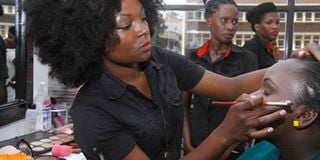Beauty courses taking big place in vocational training

Sylivia Kawalya, a makeup artist from Paramour Cosmetics applies makeup on a client. One has to enroll in a beauty school to perfect such an art. Photos by Abubaker Lubowa
What you need to know:
- Beauty schools are becoming one of the lucrative businesses today.
- This is due to the high demand for services such as hairdressing, makeup, and skincare, among others.
After completing Senior Six in 2012 at St. Peter’s Senior Secondary School, Nsambya, Darius Olivia enrolled for a Diploma in Cosmetology at YMCA Comprehensive Institute, in 2013.
“One of the practical course units I studied included beauty therapy that involved studying different aspects such as makeup, massage, facials as well as manicure and pedicure,” Olivia says, adding, “Another course unit was hairdressing where there were elements such as braiding, hairstyling and weaving.”
After completing her diploma in 2013, Olivia went on to work as a beauty therapist teacher at Kikaaya Vocational School in Mityana District for about five months.
She then worked as a makeup artist at Paramour Cosmetics Ltd in 2016 before resigning to start her own business called Sassy Chic Makeup offering both makeup services as well as selling a variety of beauty products.
“I can do any kind of makeup for a fee,” Olivia says.
The 23- year-old emphasises that beauty-themed courses should not be underestimated because there is a high demand for glamour on the market.
Kennedy Zziwa, the proprietor of Zziwa Hair Studio, is a former student of Tina Beauty School in Kampala.
“In 2012, I went to Tina Beauty School for about a month where I learnt how to plait cornrows and braids. Today, I run my own hair salon and incorporate these skills,” he says.
Challenges
Esther Baroma, the founder of Baroma School of Beauty in Mukono District, says the perception people have towards the beauty schools is often negative.
“Majority of people undermine students who enroll for beauty courses. They look at them as academic failures,” she says.
In order to resolve this, Baroma says, a lot of sensitisation needs to be done by both the government and communities through continuously educating masses on how beauty schools are positively impacting the society.
Besides the negative mentality that the masses have towards beauty schools, Baroma adds that the training equipment usually required for teaching is very expensive.
“Most of the materials we use are costly especially during the practical lessons. For instance, there are times we need about 50 pieces of hair for a class and yet each costs about Shs20,000,” she says.
Similarly, Sherry Nambajjwe, a former beauty school student, now operating her own salon says the problem with some of these schools is that they teach more theory than practical lessons. “I imagine they do that because of the costs involved in buying materials for practical lessons. This is where you find cases where one attended a beauty school but cannot plait hair,” she says.
In response, Resty Mukwaya, a cosmetologist says as much as some students despise theories, it is very helpful in enabling them understand concepts better.


